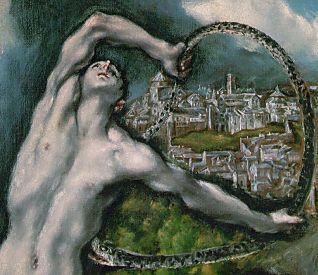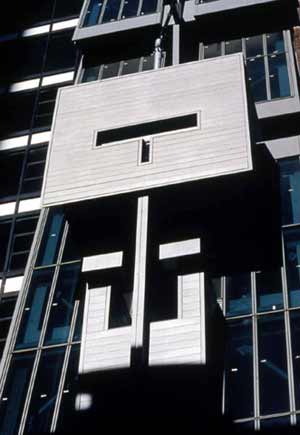RAW DATA
RAIMUND ABRAHAM


 THE REDUCTION - “There remains after this imaginary destruction of things, not something, but the fact that there is [il y a]. The absence of all things returns like a presence: like a site wherein everything has sunken, like an atmospheric density, like a plenitude of emptiness or like the murmur of silence. There is, after this destruction of things and beings, the ‘field of forces’ of existing, impersonal. Something that is neither a subject, nor a substantive. The fact of existing, which imposes itself when there is nothing more. And it is anonymous: there is no one and nothing that might take this existence upon itself. It is impersonal like ‘it is raining’ or ‘it is hot.’ An existing that returns, whatever be the negation by which one sets it aside. This is something like a pure existing that cannot be remitted.” --Emmanuel Lévinas, Le temps et l’autre, in Le choix, le monde, l’existence (Paris: Arthaud, 1948), pp. 25-26; cited in Jacques Rolland, “Getting Out of Being by a New Path”, Emmanuel Lévinas, On Escape: De l’évasion [1935], trans. Bettina Bergo (Stanford, CA: Stanford University Press, 2003), p. 25
THE REDUCTION - “There remains after this imaginary destruction of things, not something, but the fact that there is [il y a]. The absence of all things returns like a presence: like a site wherein everything has sunken, like an atmospheric density, like a plenitude of emptiness or like the murmur of silence. There is, after this destruction of things and beings, the ‘field of forces’ of existing, impersonal. Something that is neither a subject, nor a substantive. The fact of existing, which imposes itself when there is nothing more. And it is anonymous: there is no one and nothing that might take this existence upon itself. It is impersonal like ‘it is raining’ or ‘it is hot.’ An existing that returns, whatever be the negation by which one sets it aside. This is something like a pure existing that cannot be remitted.” --Emmanuel Lévinas, Le temps et l’autre, in Le choix, le monde, l’existence (Paris: Arthaud, 1948), pp. 25-26; cited in Jacques Rolland, “Getting Out of Being by a New Path”, Emmanuel Lévinas, On Escape: De l’évasion [1935], trans. Bettina Bergo (Stanford, CA: Stanford University Press, 2003), p. 25SELECT BIBLIOGRAPHY
Raimund Abraham: Unbuilt (Bozen: Forum AR/GE Kunst, 1986) - Exhibition catalogue (October 10 through 30, 1986)
“Abraham returns us to the elemental in more ways than one; not only to the elemental as Gottfried Semper would have understood it; that is, to the universally mythic but material elements of the built process -- the primordial telluric and woven compounds of earthwork, hearth, wall and roof -- but also to the elemental as a conscious recognition of omnipotent cosmic forces.” Kenneth Frampton, “Fragmentary Notes”, pp. 7-8
Image (above, right) - El Greco, "Laocoon"
“The theme of resurrection is always implicit in Abraham’s work if only because the physical and temporal continuity of the earth has invariably been an essential part of his architectural imagery.” (p. 8)
“Ten Houses” - “Suspended in the metaphysical landscape of an aftermath (1971-73)” - “Each of these houses was, in effect, an earthwork, cut into the devastated planet. Abraham’s work during this period took the form of a somnabulant archaeology, revealing both a formal syntax and a metaphysical meaning capable of interpretation at many levels. Irrespective of whether these partially ruined undercrofts were depicted bulwarks or tumuli, they were, in any event, destined to be the sites for new beginnings.” (p. 9) / In particular, see "Haus der Vorhänge" (1971), "Nine Houses" (1972-76), "The Cosmology of the House" (1974)
“Abraham distinguishes himself by virtue of his insistence on an ontology which antedates Humanism. This ontological approach in no way pre-supposes a rejection of modern technology just as it does not depend upon the exclusion of traditional materials. It seeks instead an articulate delineation of tectonic elements in which […] old and new, machine-made parts and hand-crafted materials, co-exist in an articulate continuum.” (p. 11)
Elementare Architektur / Architectonics (Salzburg: Verlag Anton Pustet, 2001)
 Manhattan Austria: die Architektur des österreichischen Kulturinstitutes von Raimund Abraham [The Architecture of the Austrian Cultural Institute by Raimund Abraham] (Vienna: Architektur Zentrum Wien; Salzburg: Verlag Anton Pustet, 1999), catalogue of the AZW exhibition, Vienna, March 24-May 10, 1999
Manhattan Austria: die Architektur des österreichischen Kulturinstitutes von Raimund Abraham [The Architecture of the Austrian Cultural Institute by Raimund Abraham] (Vienna: Architektur Zentrum Wien; Salzburg: Verlag Anton Pustet, 1999), catalogue of the AZW exhibition, Vienna, March 24-May 10, 1999Abraham Bibliography (Loeb Library, Harvard GSD)
ARTICLES / INTERVIEWS
"Raimund Abraham: Interview w/ Kenneth Frampton", Newsline, Columbia University Graduate School of Architecture, Planning and Preservation, Vol. 4, No. 1 (Sept-Oct 1991), portfolio, models, photos, site plans, pp. 4-5
"The Limits of Architecture: Raimund Abraham" [interview], Precis 6 (Spring 1987), plans, sections, model, drawings, pp. 120-126
"The Culture of Fragments", Precis 6 (Spring 1987), pp. 64-73
"Negation and Reconciliation", Perspecta 19 (1982), pp. 6-13
"Architecture and Limits", Artforum, Vol. 19, No. 7 (March 1981), axonometrics, drawings, sections, photos, pp. 45-58
"Imaginary Architecture", Space Design 3/150 (March 1977), illustrations, plans, portfolio, pp. 83-86
Image (above, left) - Raimund Abraham, Austrian Cultural Forum (New York)
SELECT PROJECTS
For JingYa Ocean Entertainment Center (Beijing, China), see Arcspace (07/04/05) ...
For the Austrian Cultural Forum (New York, New York), 1998-2002, see Arcspace (02/03/03) and/or Austrian Cultural Forum ...
Austrian Cultural Institute - Lotus International 117 (2003), photos, sections, plans, pp. 60-65; Casabella 704 (October 2002), photos, elevations, sections, plans, pp. 60-67; Architectural Review, Vol. 212, No. 1267 (September 2002), photos, sections, plans, pp. 54-[57]; A + U: Architecture and Urbanism 4/283 (April 1994), drawings, models, photos, plans, sections, aerial photos, pp. 18-[27]